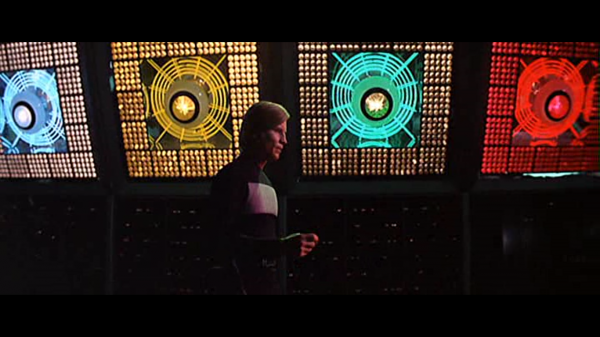User:Dave Young/tp/1-2/potemkintechnologies
This Thing is Deep in Finite Absolutes
Set Decoration from a Film
Inspired by the set design of science-fiction films such as Alien, Blade Runner, Logan's Run and Colossus: The Forbin Project, I became interested in how computers are represented in popular cinema. Before it became another accepted domestic appliance, the experience of computer technologies was mediated largely through fictions and corporate propaganda - either cinematic or literary. Companies such as IBM and Bell Labs presented 'documentaries' or info-graphic animations explaining how computers were friendly, servile devices that would perform banale tasks on behalf of their human operators. [see Eames [2]] In films such as Desk Set (released in 1955 and sponsored by IBM), follows the story of a research department where the clerks are told that they will be working alongside a computer in order to ease their workload. In an early scene, the computer races the suspicious librarians to ascertain the answers to extremely specific questions. The mystic complexity of the computer is represented through a hypnotic array of blinking lights, performing attractive animations in order to communicate the idea that it is constantly in a state of 'doing' to the audience. Ultimately, the computer is represented as a convenient accompaniment to the librarian's work, illustrating how they can be used for the general benefit of society.
The Computer as a Big Red Button
This amiable personality attributed to computers by their developers partially disguised the fact that huge percentages of their income came from military investment - a sign of the paranoid Cold War era where America was in a constant technological race with Communism in order to communicate the superiority of the Capitalist system. The link between computers and apocalyptic catastrophe was illustrated in countless science fiction books and films during this time, cultivating the possible degeneration of international relations into a profitable hysteria.
Films such as Colossus: The Forbin Project deal with the popular fear that, as computers become more complex, they would resist their subordinate capacity to humans and desire more control over their environment. Using the language of cybernetics, the supercomputer in the film (codenamed Colossus, as the film's title suggests) operates and generates a complex set of feedback loops and sensory mechanisms, allowing it to become completely autonomous from humans and adopt a hyper-rational realisation of its primary function: to prevent the onset of war between the Americans and the Soviets.
The film is a reflection on how, during the Cold War, cybernetics and computer systems were an attempt at gaining control over the future. Wiener's Predictor, the anti-aircraft gun that could augment the 'predictive' capabilities of the human operator in targeting an enemy aircraft, is an early example of this popular fascination. In this application of cybernetics, past actions and reflexes can be systematised and cataloged in order to generate a list of the most likely future actions - promising very attractive possibilities to the paranoid US military.

